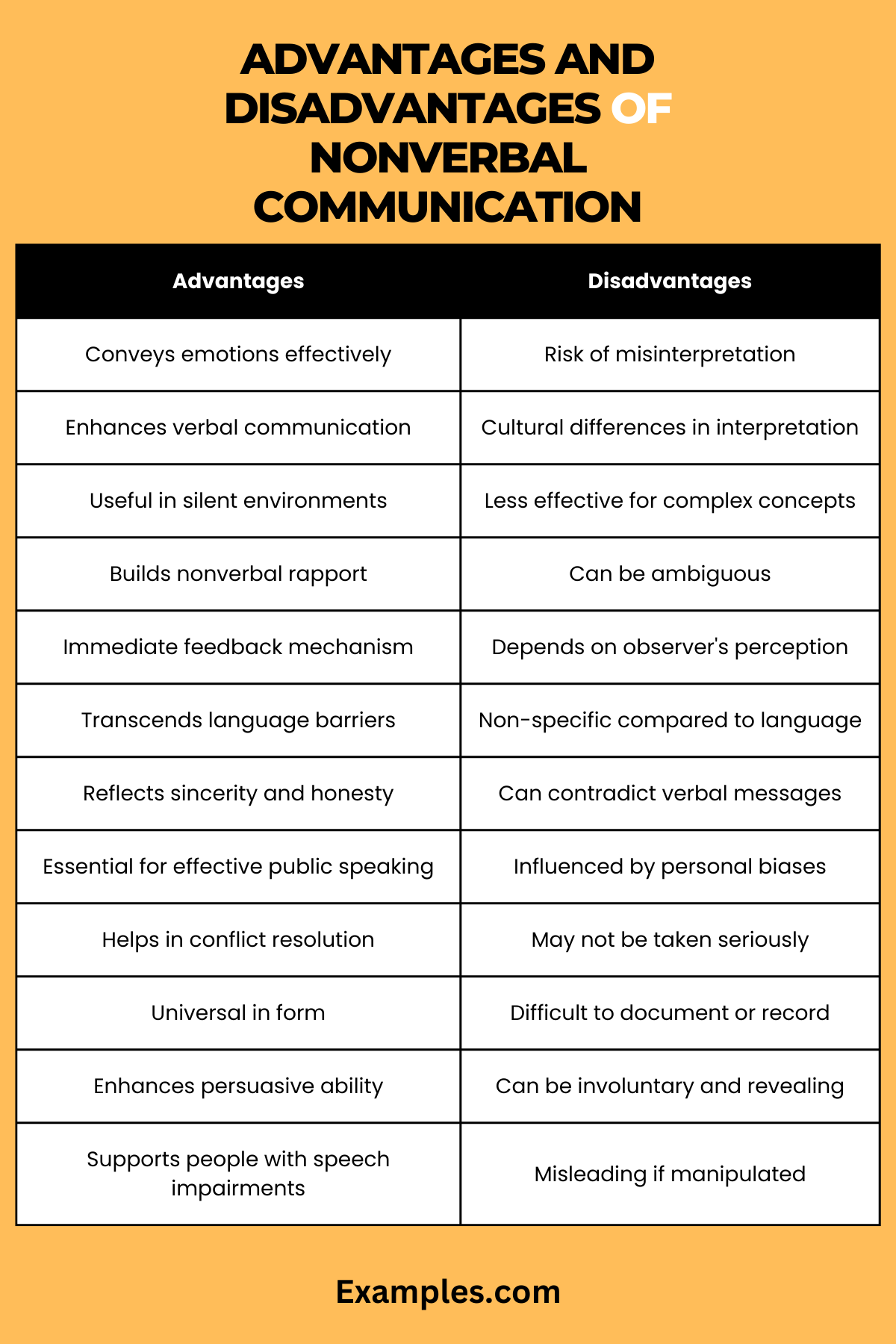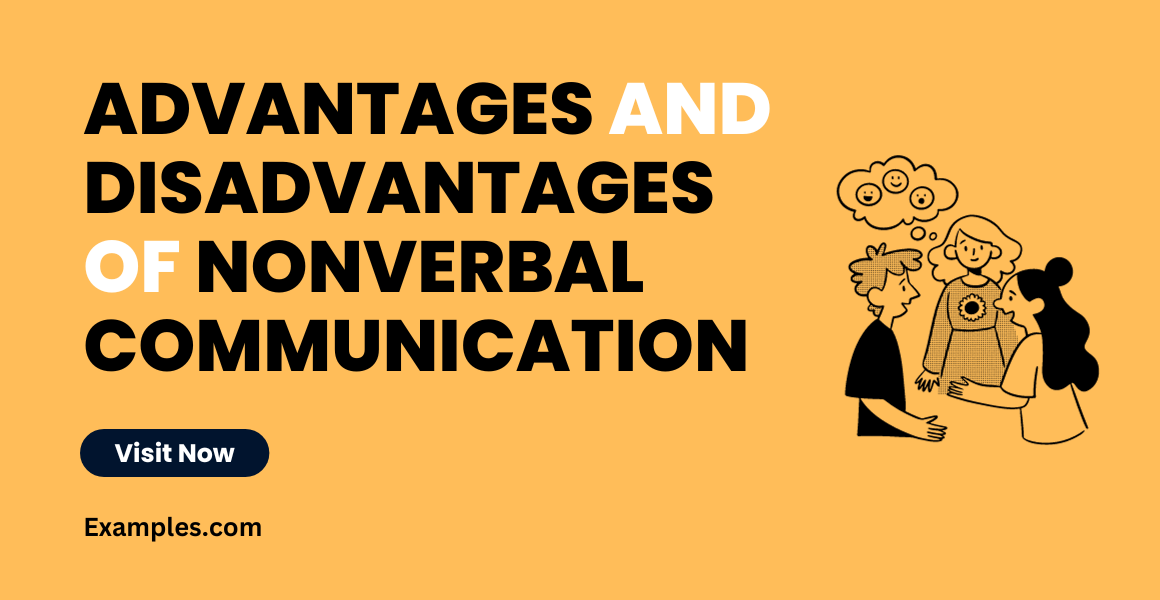29+ Advantages and Disadvantages of Nonverbal Communication Examples
Unlock the secrets of nonverbal communication with our in-depth guide. Here, we explore the subtle yet powerful world of unspoken cues and gestures, highlighting both their benefits and limitations in different contexts. Incorporating real-life nonverbal communication examples, we provide a nuanced understanding of how this silent form of expression shapes our interactions and relationships. Dive into the complexities and advantages of nonverbal communication with us.
30 Advantages and Disadvantages of Nonverbal Communication
Explore the intricate world of nonverbal communication, a key facet of human interaction. This comprehensive guide delves into its numerous benefits, like enhancing understanding and expressing emotions without words, and the challenges it presents, such as cultural misunderstandings and ambiguity. Perfect for professionals and everyday communicators alike, it highlights the nonverbal communication skills necessary in various settings, from business to personal relationships. Understand the advantages and disadvantages of nonverbal communication in different contexts, and how it complements or contrasts with verbal communication.

Advantages of Nonverbal Communication:
- Conveys Emotions Effectively: Nonverbal cues like facial expressions and gestures express emotions more vividly than words alone.
- Enhances Verbal Communication: Body language and tone add depth and meaning to spoken words.
- Useful in Silent Environments: In situations where speaking is not possible, nonverbal signals are invaluable.
- Builds Nonverbal Rapport: Shared nonverbal cues can create a sense of connection and understanding.
- Immediate Feedback Mechanism: Instant nonverbal responses provide quick insight into someone’s reaction.
- Transcends Language Barriers: Universal gestures and expressions can be understood across different languages.
- Reflects Sincerity and Honesty: Genuine nonverbal expressions are often seen as more honest than words.
- Essential for Effective Public Speaking: Effective speakers use nonverbal cues to engage and persuade audiences.
- Helps in Conflict Resolution: Nonverbal communication can convey willingness to resolve issues.
- Universal in Form: Certain nonverbal cues are recognized universally.
- Enhances Persuasive Ability: Persuaders use nonverbal signals to strengthen their arguments.
- Supports People with Speech Impairments: Nonverbal communication is crucial for those who cannot speak.
- Encourages Empathy and Understanding: Nonverbal cues help in understanding others’ emotions.
- Vital in Early Childhood Development: Children learn nonverbal cues before they can speak.
- Strengthens Interpersonal Connections: Nonverbal communication can deepen personal relationships.
- Facilitates Quick Decision-Making: Quick nonverbal assessments can lead to fast decisions.
- Helps in Negotiation and Diplomacy: Subtle nonverbal cues are key in delicate negotiations.
- Effective in Storytelling and Art: Artists and storytellers use nonverbal elements to convey messages.
- Useful in Confidential Communication: Nonverbal signals can convey messages discreetly.
- Integral to Sign Language: Sign language relies entirely on nonverbal communication.
- Conveys Authority and Leadership: Leaders often use nonverbal cues to assert authority.
- Essential in Acting and Performance: Performers rely heavily on nonverbal expression.
- Can Be More Honest Than Verbal Cues: Nonverbal reactions are often more spontaneous and genuine.
- Enhances Listening Skills: Observing nonverbal cues improves overall listening ability.
- Reflects Individual Personality: Personal nonverbal styles reveal much about someone’s character.
- Signals Agreement or Disagreement Subtly: Nonverbal cues can discreetly show concurrence or dissent.
- Assists in Teaching and Learning: Teachers and students use nonverbal communication for better understanding.
- Influential in Marketing and Advertising: Advertisements often use nonverbal cues to influence emotions and decisions.
- Helps in Assessing Situations Quickly: Quick nonverbal reads can inform immediate reactions.
- Facilitates Silent Communication in Shared Spaces: Nonverbal signals enable communication in quiet environments.
Disadvantages of Nonverbal Communication:
- Risk of Misinterpretation: Nonverbal cues can be misunderstood, leading to confusion.
- Cultural Differences in Interpretation: Nonverbal signals vary greatly between cultures, causing miscommunication.
- Less Effective for Complex Concepts: Nonverbal communication is limited in conveying detailed or abstract ideas.
- Can Be Ambiguous: Nonverbal signals are often open to multiple interpretations.
- Depends on Observer’s Perception: The understanding of nonverbal cues relies heavily on the observer’s background and perceptions.
- Non-Specific Compared to Language: Nonverbal communication lacks the specificity and nuance of verbal language.
- Can Contradict Verbal Messages: Inconsistent nonverbal cues can undermine spoken words.
- Influenced by Personal Biases: Interpretations of nonverbal signals can be skewed by personal prejudices.
- May Not Be Taken Seriously: Some people might disregard nonverbal communication as insignificant.
- Difficult to Document or Record: Capturing nonverbal communication for record-keeping is challenging.
- Can Be Involuntary and Revealing: Unintentional nonverbal signals can inadvertently disclose true feelings.
- Misleading if Manipulated: Deliberately altered nonverbal behavior can deceive observers.
- Varying Interpretations Among Audiences: Different groups may interpret the same nonverbal cues differently.
- Overlooked in Formal Settings: In formal or professional contexts, nonverbal communication is often undervalued.
- Requires Close Observation: Understanding nonverbal cues demands attentive observation.
- May Be Inconsistent: Nonverbal behavior can vary, leading to mixed messages.
- Inadequate for Detailed Instructions: Complex instructions are difficult to convey nonverbally.
- Potentially Offensive if Misused: Inappropriate nonverbal gestures can offend or upset.
- Affected by Physical Surroundings: The environment can influence the interpretation of nonverbal cues.
- Misunderstood Due to Lack of Context: Without verbal context, nonverbal communication can be misinterpreted.
- Requires Cultural Sensitivity: Understanding nonverbal cues in different cultures demands awareness and sensitivity.
- Difficult to Interpret Over Digital Media: Digital communication limits the effectiveness of nonverbal cues.
- Ignored or Unnoticed in Fast-Paced Settings: In busy environments, nonverbal signals may be overlooked.
- Limited in Expressing Precise Information: Nonverbal communication is not suited for conveying specific, detailed information.
- May Be Interpreted as Disrespectful: Certain nonverbal gestures might be seen as rude or inappropriate.
- Challenging for Visually Impaired Individuals: People with visual impairments may miss out on nonverbal cues.
- May Conflict with Spoken Words: Discrepancies between verbal and nonverbal messages can create confusion.
- Varies with Personal Space Norms: Different cultures have varied norms regarding personal space, affecting nonverbal communication.
- Subject to Personal Habits and Quirks: Individual mannerisms can distort the intended message of nonverbal cues.
- May Be Overshadowed by Verbal Communication: In dialogue-heavy contexts, nonverbal signals can be ignored.
Different Advantages and Disadvantages of Nonverbal Communication
Nonverbal communication, a critical aspect of interpersonal interactions, involves conveying and interpreting messages without words. This form of communication, including gestures, facial expressions, body language, and even the physical distance between individuals, is key in effective communication skills. Understanding the varied aspects of nonverbal communication, its advantages, and its disadvantages, is crucial for enhancing personal and professional relationships.
Advantages
- Enhances Understanding: Nonverbal cues, a pivotal aspect of effective communication, complement and reinforce verbal messages, making the conveyance of information more comprehensive.
- Expresses Emotions: The ability to express emotions accurately is often more achievable through nonverbal expressions than words, a crucial element in emotional intelligence.
- Universal Elements: Certain nonverbal cues transcend language barriers, making them a universal language in many respects.
- Instant Feedback: Nonverbal responses offer immediate feedback, essential in adjusting communication strategies in real-time.
- Supports Verbal Limitations: For those facing challenges in verbal communication, nonverbal cues are indispensable, highlighting the inclusivity of nonverbal communication.
- Indicates Sincerity: The sincerity of a message is often gauged more accurately through nonverbal cues than verbal communication.
Disadvantages
- Risk of Misinterpretation: Nonverbal cues, due to their ambiguity, are prone to misinterpretation, a significant barrier in effective communication.
- Cultural Variations: Nonverbal communication varies across cultures, leading to potential misunderstandings in cross-cultural communication.
- Subtlety and Complexity: The subtle nature of nonverbal cues adds complexity to interpersonal communication.
- Inconsistency: Inconsistent nonverbal behavior can contradict verbal messages, causing confusion.
- Lack of Formal Documentation: Unlike verbal communication, nonverbal interactions are challenging to document, reducing their utility in formal contexts.
Advantages and Disadvantages of Verbal and Nonverbal Communication
In the realm of communication skills, both verbal and nonverbal communication play vital roles, each contributing uniquely to the way we interact and understand each other.
Advantages of Verbal Communication
- Clarity and Precision: Verbal communication, essential in conveying detailed information, offers clarity and precision, key in effective communication.
- Documentation: The ability to record and archive verbal communication is invaluable in formal and legal contexts.
- Directness: Verbal communication, in its directness, often reduces the likelihood of the misinterpretation common in nonverbal cues.
- Effectiveness in Formal Settings: In formal environments like business meetings, verbal communication is often more appropriate and effective.
Disadvantages of Verbal Communication
- Language Barriers: Verbal communication is limited by language differences, a significant challenge in cross-cultural communication.
- Misinterpretation: Despite its clarity, verbal communication is still prone to misinterpretation, particularly in emotional intelligence contexts.
- Over-reliance on Words: An exclusive focus on verbal communication can overlook the powerful subtleties of nonverbal cues.
Balancing Verbal and Nonverbal Communication
Effective communication skills involve balancing verbal and nonverbal cues. While verbal communication conveys specific information, nonverbal cues add emotional depth to interactions. Awareness and skillful use of both forms are key to successful communication, especially in personal and professional settings. To enhance communication skills, one should focus on both verbal and nonverbal communication techniques.
Advantages and Disadvantages of Nonverbal Communication in Business
In the business world, nonverbal communication plays a crucial role in enhancing interactions and conveying messages beyond words. Understanding its advantages and disadvantages is key to effective business communication, essential for successful professional relationships and corporate growth.

Advantages
- Strengthens Business Relationships: Nonverbal cues like a firm handshake or direct eye contact establish trust and rapport in business settings.
- Enhances Presentation Skills: Effective nonverbal communication, such as confident body language, can make business presentations more engaging and persuasive.
- Facilitates Negotiations: In business negotiations, reading and using nonverbal cues effectively can give an edge in understanding and influencing counterparts.
- Conveys Leadership and Authority: Leaders often use nonverbal communication to assert authority and inspire confidence in their team.
- Supports Team Collaboration: Nonverbal cues help in interpreting team dynamics and managing conflicts, essential in team management.
Disadvantages
- Misinterpretations in Business Contexts: Misreading nonverbal signals can lead to misunderstandings, affecting business decisions and relationships.
- Cultural Misunderstandings: With global business interactions, differing cultural interpretations of nonverbal communication can create challenges in international business.
- Inconsistency with Verbal Messages: Discrepancies between what is said and nonverbal expressions can lead to distrust in business environments.
- Limitations in Remote Work: In the era of remote work and digital communication, the absence of nonverbal cues can hinder clear understanding in virtual teams.
Advantages and Disadvantages of Nonverbal Communication in the Workplace
Nonverbal communication in the workplace encompasses all the unspoken interactions that occur in a professional setting, playing a significant role in workplace dynamics and employee relations.

Advantages
- Improves Workplace Relationships: Positive nonverbal communication fosters a more collaborative and friendly workplace environment.
- Enhances Employee Engagement: Leaders who use effective nonverbal communication can better engage and motivate their employees.
- Aids in Conflict Resolution: Nonverbal cues can help in detecting and resolving conflicts early in the workplace.
- Reflects Professionalism: Appropriate nonverbal behavior, like maintaining good posture, reflects professionalism and competence.
- Supports Effective Management: Managers skilled in reading nonverbal cues can better understand and lead their teams.
Disadvantages
- Risk of Miscommunication: Misinterpreted nonverbal signals can lead to workplace misunderstandings and tension.
- Can Create a Negative Atmosphere: Negative nonverbal communication, like avoiding eye contact, can create an unwelcoming work environment.
- Difficulties in Virtual Communication: In remote working scenarios, the lack of nonverbal cues can make communication less personal and more challenging.
- May Lead to Bias: Nonverbal cues can sometimes lead to unconscious biases, affecting decisions in talent management and team dynamics.
Incorporating an understanding of nonverbal communication in both business and workplace settings is vital for enhancing professional interactions, team management, and overall corporate communication. However, being mindful of its potential downsides is equally important to avoid misinterpretations and cultural misunderstandings, especially in diverse and remote work environments.
Advantages and Disadvantages of Using Nonverbal Communication
Nonverbal communication, which includes gestures, facial expressions, body language, and other visual cues, is an integral part of human interaction. Its use, both in personal and professional contexts, offers several advantages but also comes with its own set of challenges.
Advantages
- Enhances Clarity and Understanding: Nonverbal cues often complement verbal communication, providing additional context and clarity to the spoken word.
- Expresses Emotions More Effectively: Emotions are more readily and authentically conveyed through nonverbal means such as facial expressions and body language.
- Facilitates Quick Communication: Nonverbal signals like a nod or a smile convey messages instantly without the need for words.
- Transcends Language Barriers: Nonverbal cues can bridge communication gaps where language barriers exist, making them a universal form of communication.
- Indicates Sincerity: Often, nonverbal behavior is less controlled than speech, making it a more genuine indicator of a person’s feelings and intentions.
- Useful in Diverse Situations: Nonverbal communication is crucial in situations where verbal communication is not possible, such as in noisy environments or when discretion is needed.
Disadvantages
- Risk of Misinterpretation: Without the clarity that words provide, nonverbal signals can be easily misunderstood, leading to miscommunication.
- Cultural Differences: Nonverbal cues vary significantly across cultures, and what is considered polite or appropriate in one culture may be offensive in another.
- Limited in Conveying Complex Information: Nonverbal communication is not effective for conveying detailed or complex messages.
- Subtlety and Subjectivity: Nonverbal cues can be subtle and open to subjective interpretation, making them less reliable than verbal communication.
- Inconsistency with Verbal Communication: When nonverbal cues do not align with verbal messages, it can lead to confusion and mistrust.
- Challenges in Documentation: Unlike verbal communication, nonverbal interactions are difficult to document and record, making them less useful in situations where record-keeping is important.
Understanding and effectively using nonverbal communication is a valuable skill, enhancing the depth and effectiveness of interpersonal interactions. However, it is essential to be aware of its limitations and potential for misinterpretation, particularly in cross-cultural contexts. Balancing nonverbal cues with verbal communication can lead to more effective and meaningful interactions.
In conclusion, mastering nonverbal communication enhances interpersonal skills and emotional intelligence. Understanding its advantages and disadvantages is crucial for effective communication. This guide provides essential tips for navigating the nuances of nonverbal cues, vital in both personal and professional settings. Embracing these insights leads to improved understanding and stronger connections, making nonverbal communication a key component of successful interactions.



